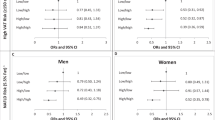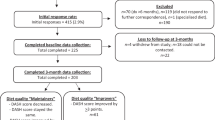Abstract
Background/Objectives:
The dietary inflammatory index (DII) measured at one time point is associated with risk of several chronic diseases, but disease risk may change with longitudinal changes in DII scores. Data are lacking regarding changes in DII scores over time; therefore, we assessed changes in the DII in the Women’s Health Initiative (WHI).
Subjects/Methods:
DII scores were calculated using data from repeated food frequency questionnaires in the WHI Observational Study (OS; n=76 671) at baseline and year 3, and the WHI Dietary Modification trial (DM; n=48482) at three time points. Lower DII scores represent more anti-inflammatory diets. We used generalized estimating equations to compare mean changes in DII over time, adjusting for multiple comparisons, and multivariable-adjusted linear regression analyses to determine predictors of DII change.
Results:
In the OS, mean DII decreased modestly from −1.14 at baseline to −1.50 at year 3. In the DM, DII was −1.32 in year 1, −1.60 in year 3 and −1.48 in year 6 in the intervention arm and was −0.65 in year 1, −0.94 in year 3 and −0.96 in year 6 in the control arm. These changes were modified by body mass index, education and race/ethnicity. A prediction model explained 22% of the variance in the change in DII scores in the OS.
Conclusions:
In this prospective investigation of postmenopausal women, reported dietary inflammatory potential decreased modestly over time. Largest reductions were observed in normal-weight, highly educated women. Future research is warranted to examine whether reductions in DII are associated with decreased chronic disease risk.
This is a preview of subscription content, access via your institution
Access options
Subscribe to this journal
Receive 12 print issues and online access
$259.00 per year
only $21.58 per issue
Buy this article
- Purchase on Springer Link
- Instant access to full article PDF
Prices may be subject to local taxes which are calculated during checkout





Similar content being viewed by others
References
Hu FB . Dietary pattern analysis: a new direction in nutritional epidemiology. Curr Opin Lipidol 2002; 13: 3–9.
Randall E, Marshall JR, Graham S, Brasure J . Patterns in food use and their associations with nutrient intakes. Am J Clin Nutr 1990; 52: 739–745.
Chrysohoou C, Panagiotakos DB, Pitsavos C, Das UN, Stefanadis C . Adherence to the mediterranean diet attenuates inflammation and coagulation process in healthy adults: The ATTICA Study. J Am Coll Cardiol 2004; 44: 152–158.
Jacques PF, Tucker KL . Are dietary patterns useful for understanding the role of diet in chronic disease? Am J Clin Nutr 2001; 73: 1–2.
McCullough ML . Diet patterns and mortality: common threads and consistent results. J Nutr 2014; 144: 795–796.
Reedy J, Krebs-Smith SM, Miller PE, Liese AD, Kahle LL, Park Y et al. Higher diet quality is associated with decreased risk of all-cause, cardiovascular disease, and cancer mortality among older adults. J Nutr 2014; 144: 881–889.
Miller PE, Cross AJ, Subar AF, Krebs-Smith SM, Park Y, Powell-Wiley T et al. Comparison of 4 established DASH diet indexes: examining associations of index scores and colorectal cancer. Am J Clin Nutr 2013; 98: 794–803.
Mulder M, Ranchor AV, Sanderman R, Bouma J, van den Heuvel WJ . The stability of lifestyle behaviour. Int J Epidemiol 1998; 27: 199–207.
Mishra GD, McNaughton SA, Bramwell GD, Wadsworth ME . Longitudinal changes in dietary patterns during adult life. Br J Nutr 2006; 96: 735–744.
Borland SE, Robinson SM, Crozier SR, Inskip HM, SWS Study Group. Stability of dietary patterns in young women over a 2-year period. Br J Clin Nutr 2008; 62: 119–126.
Weismayer C, Anderson JG, Wolk A . Changes in the stability of dietary patterns in a study of middle-aged Swedish women. J Nutr 2006; 136: 1582–1587.
Bertheke PG, de Vente W, Kemper HC, Twisk JW . Longitudinal trends in and tracking of energy and nutrient intake over 20 years in a Dutch cohort of men and women between 13 and 33 years of age: the Amsterdam growth and health longitudinal study. Br J Nutr 2001; 85: 375–385.
Newby PK, Weismayer C, Akesson A, Tucker KL, Wolk A . Long-term stability of food patterns identified by use of factor analysis among Swedish women. J Nutr 2006; 136: 626–633.
Northstone K, Emmett PM . Are dietary patterns stable throughout early and mid-childhood? a birth cohort study. Br J Nutr 2008; 100: 1069–1076.
Tinker LF, Rosal MC, Young AF, Perri MG, Patterson RE, Van Horn L et al. Predictors of dietary change and maintenance in the Women’s Health Initiative Dietary Modification Trial. J Am Diet Assoc 2007; 107: 1155–1165.
Davis NJ, Ma Y, Delahanty LM, Hoffman HJ, Mayer-Davis E, Franks PW et alDiabetes Prevention Program Research Group. Predictors of sustained reduction in energy and fat intake in the Diabetes Prevention Program Outcomes Study Intensive Lifestyle Intervention. J Acad Nutr Diet 2013; 113: 1455–1464.
Hébert JR, Wirth M, Davis L, Davis B, Harmon BE, Hurley TG et al. C-reactive protein levels in African Americans: a diet and lifestyle randomized community trial. Am J Prev Med 2013; 45: 430–440.
Shivappa N, Steck SE, Hurley TG, Hussey JR, Hebert JR . Designing and developing a literature-derived, population-based dietary inflammatory index. Public Health Nutr 2013; 17: 1689–1696.
Shivappa N, Steck SE, Hurley TG, Hussey JR, Ma Y, Ockene IS et al. A population-based dietary inflammatory index predicts levels of C-reactive protein in the Seasonal Variation of Blood Cholesterol Study (SEASONS). Public Health Nutr 2013; 17: 1825–1833.
Tabung FK, Steck SE, Zhang J, Ma Y, Liese AD, Agalliu I et al. Construct validation of the dietary inflammatory index among postmenopausal women. Ann Epidemiol 2015; 25: 398–405.
Patterson RE, Kristal AR, Tinker LF, Carter RA, Bolton MP, Agurs-Collins T . Measurement characteristics of the Women’s Health Initiative food frequency questionnaire. Ann Epidemiol 1999; 9: 178–187.
Women’s Health Initiative Study Group. Design of the Women’s Health Initiative clinical trial and observational study. Control Clin Trials 1998; 19: 61–109.
Prentice RL, Mossavar-Rahmani Y, Huang Y, Van Horn L, Beresford SA, Caan B et al. Evaluation and comparison of food records, recalls, and frequencies for energy and protein assessment by using recovery biomarkers. Am J Epidemiol 2011; 174: 591–603.
Neuhouser ML, Tinker L, Shaw PA, Schoeller D, Bingham SA, Horn LV et al. Use of recovery biomarkers to calibrate nutrient consumption self-reports in the Women's Health Initiative. Am J Epidemiol 2008; 167: 1247–1259.
Ritenbaugh C, Patterson RE, Chlebowski RT, Caan B, Fels-Tinker L, Howard B et al. The Women's Health Initiative Dietary Modification trial: overview and baseline characteristics of participants. Ann Epidemiol 2003; 13: S87–S97.
Patterson RE, Neuhouser ML, Hedderson MM, Schwartz SM, Standish LJ, Bowen DJ . Changes in diet, physical activity, and supplement use among adults diagnosed with cancer. J Am Diet Assoc 2003; 103: 323–328.
Nutrition Coordinating Center at the University of Minnesota M MN Nutrition Data System for Research (NDSR). University of Minnesota: Minneapolis, MN, 2013.
Sijtsma FP, Meyer KA, Steffen LM, Shikany JM, Van Horn L, Harnack L et al. Longitudinal trends in diet and effects of sex, race, and education on dietary quality score change: the Coronary Artery Risk Development in Young Adults study. Am J Clin Nutr 2012; 95: 580–586.
Chaix B, Bean K, Daniel M, Zenk SN, Kestens Y, Charreire H et al. Associations of supermarket characteristics with weight status and body fat: a multilevel analysis of individuals within supermarkets (RECORD Study). PLoS One 2012; 7: e32908.
Drewnowski AMA, Jiao J, Aggarwal A, Charreire H, Chaix B . Food environment and socioeconomic status influence obesity rates in Seattle and in Paris. Int J Obes (Lond) 2014; 38: 306–314.
Brenner DR, Boucher BA, Kreiger N, Jenkins D, El-Sohemy A . Dietary patterns in an ethnoculturally diverse population of young Canadian adults. Can J Diet Pract Res 2011; 72: e161–e168.
Garduño-Diaz SD, Khokhar S . South Asian dietary patterns and their association with risk factors for the metabolic syndrome. J Hum Nutr Diet 2013; 26: 145–155.
Hays J, Hunt JR, Hubbell FA, Anderson GL, Limacher M, Allen C et al. The Women's Health Initiative recruitment methods and results. Ann Epidemiol 2003; 13: S18–S77.
Hebert JR, Clemow L, Pbert L, Ockene IS, Ockene JK . Social desirability bias in dietary self-report may compromise the validity of dietary intake measures. Int J Epidemiol 1995; 24: 389–398.
Hebert JR, Ma Y, Clemow L, Ockene IS, Saperia G, Stanek EJ 3rd et al. Gender differences in social desirability and social approval bias in dietary self-report. Am J Epidemiol 1997; 146: 1046–1055.
Wirth MD, Burch J, Shivappa N, Steck SE, Hurley TG, Vena JE et al. Dietary inflammatory index scores differ by shift work status: NHANES 2005 to 2010. J Occup Environ Med 2014; 56: 145–148.
Snedecor GW, Cochran WG . Statistical Methods, 8th edn. Iowa State University Press: Ames, IA, 1989; Vol. 276.
Acknowledgements
FKT and JRH were supported by National Cancer Institute grants numbers F31CA177255 and K05CA136975, respectively. The WHI program was funded by the National Heart, Lung, and Blood Institute, National Institutes of Health, the US Department of Health and Human Services through contracts HHSN268201100046C, HHSN268201100001C, HHSN268201100002C, HHSN268201100003C, HHSN268201100004C and HHSN271201100004C.
Author information
Authors and Affiliations
Corresponding author
Ethics declarations
Competing interests
JRH owns controlling interest in Connecting Health Innovations LLC (CHI), a company planning to license the right to his invention of the dietary inflammatory index (DII) from the University of South Carolina in order to develop computer and smart phone applications for patient counseling and dietary intervention in clinical settings.
Additional information
Supplementary Information accompanies this paper on European Journal of Clinical Nutrition website
Supplementary information
Rights and permissions
About this article
Cite this article
Tabung, F., Steck, S., Zhang, J. et al. Longitudinal changes in the dietary inflammatory index: an assessment of the inflammatory potential of diet over time in postmenopausal women. Eur J Clin Nutr 70, 1374–1380 (2016). https://doi.org/10.1038/ejcn.2016.116
Received:
Revised:
Accepted:
Published:
Issue Date:
DOI: https://doi.org/10.1038/ejcn.2016.116
This article is cited by
-
Association between dietary inflammatory potential and mortality after cancer diagnosis in the Women’s Health Initiative
British Journal of Cancer (2023)
-
Post-cancer diagnosis dietary inflammatory potential is associated with survival among women diagnosed with colorectal cancer in the Women’s Health Initiative
European Journal of Nutrition (2020)
-
Education and lifestyle predict change in dietary patterns and diet quality of adults 55 years and over
Nutrition Journal (2019)
-
Secular trends in Dietary Inflammatory Index among adults in the United States, 1999–2014
European Journal of Clinical Nutrition (2019)



